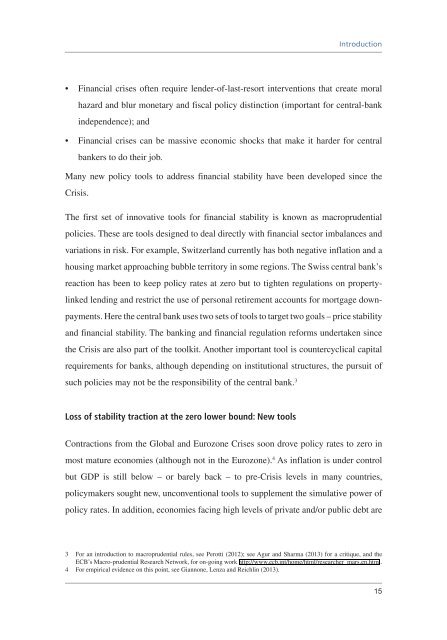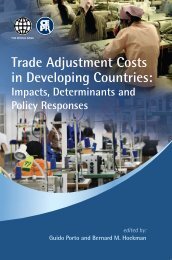Is inflation targeting dead? Central Banking After the Crisis - Vox
Is inflation targeting dead? Central Banking After the Crisis - Vox
Is inflation targeting dead? Central Banking After the Crisis - Vox
Create successful ePaper yourself
Turn your PDF publications into a flip-book with our unique Google optimized e-Paper software.
Introduction• Financial crises often require lender-of-last-resort interventions that create moralhazard and blur monetary and fiscal policy distinction (important for central-bankindependence); and• Financial crises can be massive economic shocks that make it harder for centralbankers to do <strong>the</strong>ir job.Many new policy tools to address financial stability have been developed since <strong>the</strong><strong>Crisis</strong>.The first set of innovative tools for financial stability is known as macroprudentialpolicies. These are tools designed to deal directly with financial sector imbalances andvariations in risk. For example, Switzerland currently has both negative <strong>inflation</strong> and ahousing market approaching bubble territory in some regions. The Swiss central bank’sreaction has been to keep policy rates at zero but to tighten regulations on propertylinkedlending and restrict <strong>the</strong> use of personal retirement accounts for mortgage downpayments.Here <strong>the</strong> central bank uses two sets of tools to target two goals – price stabilityand financial stability. The banking and financial regulation reforms undertaken since<strong>the</strong> <strong>Crisis</strong> are also part of <strong>the</strong> toolkit. Ano<strong>the</strong>r important tool is countercyclical capitalrequirements for banks, although depending on institutional structures, <strong>the</strong> pursuit ofsuch policies may not be <strong>the</strong> responsibility of <strong>the</strong> central bank. 3Loss of stability traction at <strong>the</strong> zero lower bound: New toolsContractions from <strong>the</strong> Global and Eurozone Crises soon drove policy rates to zero inmost mature economies (although not in <strong>the</strong> Eurozone). 4 As <strong>inflation</strong> is under controlbut GDP is still below – or barely back – to pre-<strong>Crisis</strong> levels in many countries,policymakers sought new, unconventional tools to supplement <strong>the</strong> simulative power ofpolicy rates. In addition, economies facing high levels of private and/or public debt are3 For an introduction to macroprudential rules, see Perotti (2012); see Agur and Sharma (2013) for a critique, and <strong>the</strong>ECB’s Macro-prudential Research Network, for on-going work http://www.ecb.int/home/html/researcher_mars.en.html.4 For empirical evidence on this point, see Giannone, Lenza and Reichlin (2013).15














